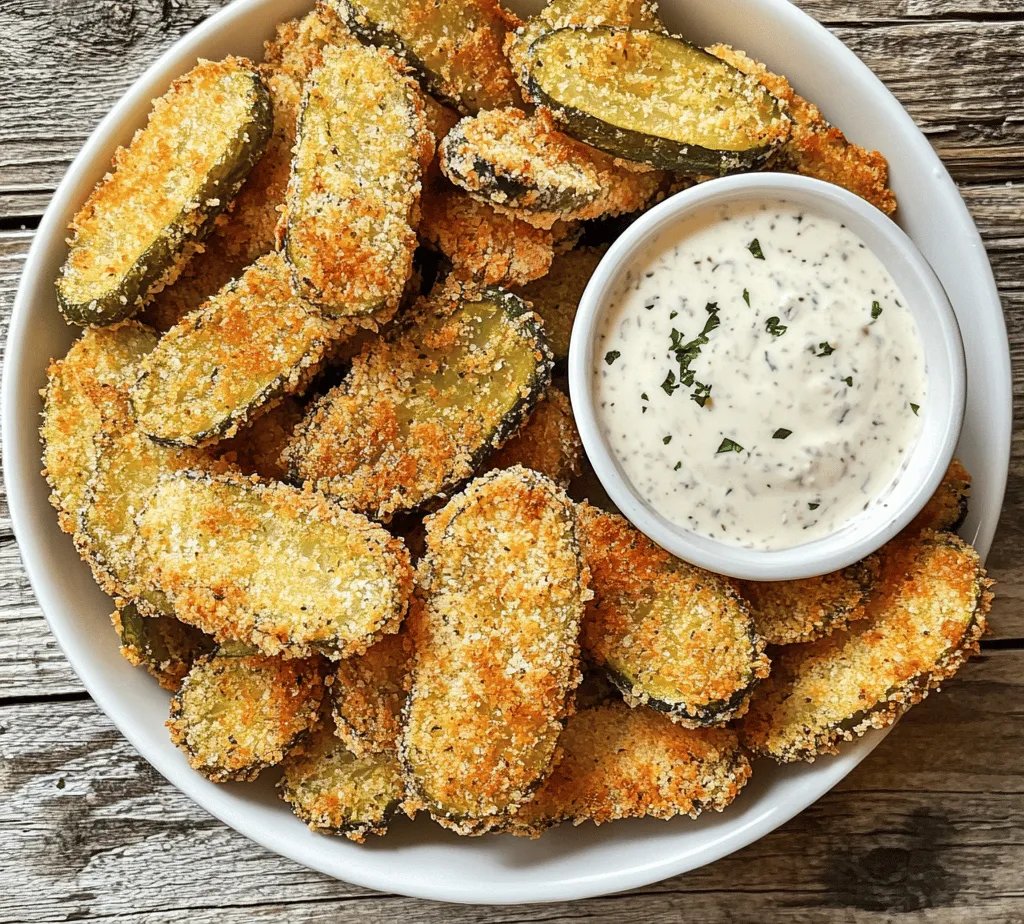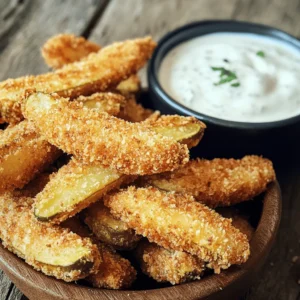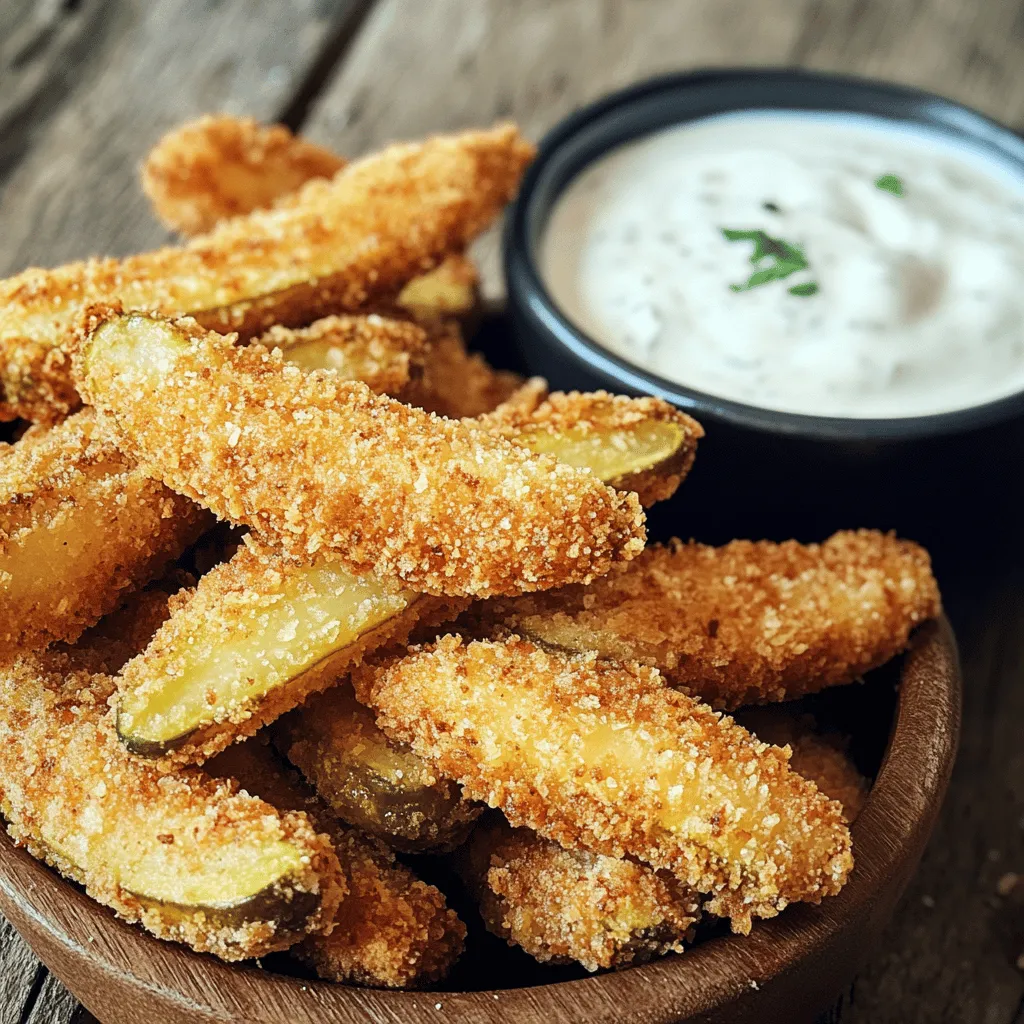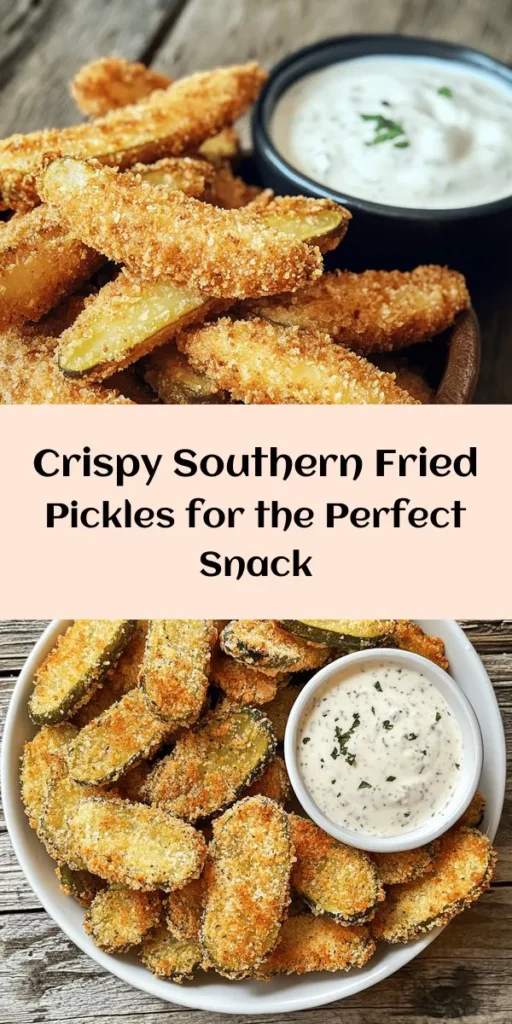Fried pickles are not just a snack; they are an experience, particularly cherished in the Southern United States. This crispy, tangy treat marries the crunch of dill pickles with a seasoned batter, creating a delightful contrast that is both comforting and satisfying. It’s no wonder that Southern Fried Pickles have gained popularity beyond their regional roots, making their way onto appetizer menus in restaurants and into homes across the nation. Whether you’re preparing for a casual get-together, a game day celebration, or simply indulging in a culinary project, this recipe for Crispy Southern Fried Pickles is bound to impress your guests and tantalize your taste buds. In this article, we’ll take a deep dive into the ingredients, preparation steps, and some intriguing facts about this iconic dish.
Understanding the Core Ingredients
The foundation of any great dish lies in its ingredients. For our crispy fried pickles, we’ll explore the essential components that contribute to their deliciousness and unique texture.
Dill Pickle Spears: The Star of the Show
At the heart of the fried pickle experience are the dill pickles themselves. Choosing the right pickles is fundamental to the success of this recipe. Dill pickles provide that quintessential sour punch that contrasts beautifully with the crispy coating. When it comes to selecting your pickles, you have two main options: homemade vs. store-bought.
Homemade pickles allow for customization in flavor. You can experiment with various spices, sweetness levels, and even the size of the pickles. However, if time is of the essence, store-bought dill pickles are a convenient option. Look for pickles that are firm and have a vibrant color, as these will yield the best results when fried.
Different types of dill pickles can also influence the flavor profile of your fried pickles. For instance, bread and butter pickles offer a sweeter taste, while kosher dills provide a more robust herbal flavor. Ultimately, the type of pickle you choose will set the stage for the overall taste of your dish.
The Breading Mixture: A Flavorful Coating
The batter is where the magic happens, transforming simple pickles into a mouthwatering snack. The breading mixture primarily consists of flour, cornmeal, and a blend of spices.
– Flour serves as the base of the batter and helps create a sturdy coating.
– Cornmeal adds a unique crunch that elevates the texture, giving your fried pickles that desirable crispiness.
– Spices such as garlic powder, onion powder, cayenne pepper, paprika, salt, and black pepper play a pivotal role in enhancing the flavor profile. Each of these components contributes layers of taste, ensuring that every bite is savory and satisfying.
The combination of flour and cornmeal not only helps in achieving a crispy exterior but also adds depth to the overall taste. The cornmeal, in particular, is crucial for texture, providing that crunch that makes fried pickles irresistible.
The Wet Mixture: Binding the Coating
To achieve a crunchy exterior, the wet mixture is just as important as the dry ingredients. In our recipe, we use eggs and buttermilk to create a batter that binds the coating to the pickles.
– Eggs act as a binding agent, helping the breading adhere well during the frying process.
– Buttermilk not only adds richness but also contributes to the crispy texture of the fried pickles. The acidity in buttermilk helps tenderize the batter, resulting in a lighter, crunchier coating.
For those with dietary restrictions, there are alternatives to consider. You can substitute regular buttermilk with dairy-free options such as almond milk mixed with a bit of vinegar or lemon juice. Similarly, flax eggs can be used as a substitute for traditional eggs, making this recipe accessible to vegans or those with egg allergies.
Preparation Steps for Perfectly Fried Pickles
The preparation process is crucial for achieving that ideal crispy texture. Here, we’ll provide an in-depth look at each step involved in creating the perfect fried pickles.
Preparing the Pickles: Ensuring Crispiness
Before you dive into the frying process, preparing the pickles correctly is essential for ensuring they turn out crispy rather than soggy. This starts with draining and drying the pickles.
1. Draining: Place the dill pickle spears in a colander or on a wire rack over a plate. Allow them to drain for at least 30 minutes. This step helps remove excess brine, which can lead to a soggy coating.
2. Drying: After draining, pat the pickles dry with paper towels. This step is crucial; moisture is the enemy of a crispy crust. The drier the pickles are, the better your batter will adhere, resulting in a perfect crunch.
Creating the Breading and Wet Mixtures
Once your pickles are prepped, you can move on to creating the breading and wet mixtures.
1. Combining the Dry Ingredients: In a large mixing bowl, whisk together the flour, cornmeal, and all the spices. The goal is to ensure an even distribution of flavors throughout the batter.
2. Preparing the Wet Mixture: In a separate bowl, whisk together the eggs and buttermilk until smooth. This mixture should be well combined to ensure it coats the pickles evenly.
3. Achieving the Right Consistency: The wet mixture should be thick enough to cling to the pickles but not too thick that it overwhelms them. If it seems too runny, add a bit more flour; if it’s too thick, a splash of buttermilk will help loosen it.
Coating the Pickles: Getting the Perfect Crunch
Now that you have your pickles prepped and your mixtures ready, it’s time to coat the pickles for frying.
1. Dipping Process: Take each pickle spear, dip it into the wet mixture first, ensuring it is fully coated. Allow any excess batter to drip off before proceeding to the next step.
2. Coating with the Dry Mixture: After dipping in the wet mixture, immediately transfer the pickle to the bowl with the dry breading mixture. Ensure each spear is thoroughly coated, pressing the mixture onto the pickles gently but firmly. This step is crucial for achieving that crunchy exterior.
3. Resting Before Frying: Once all the pickles are coated, let them sit for about 10 minutes. This resting period allows the batter to adhere better to the pickles, enhancing the crunchiness when fried.
By following these preparation steps meticulously, you’ll set the stage for perfectly crispy Southern Fried Pickles that are sure to be a hit at any gathering. The combination of tangy dill pickles with a flavorful, crunchy coating creates a snack that is not only delicious but also deeply satisfying. In the next part of our article, we will explore the frying process, tips for achieving the perfect golden brown finish, and some serving suggestions to elevate your fried pickle experience.

Frying Techniques for Optimal Results
Achieving the perfect crispy Southern fried pickles hinges on mastering a few key frying techniques. Understanding the right oil, temperature, and cooking methods will elevate your fried pickle experience, ensuring they come out golden brown, crunchy, and delicious every time.
Choosing the Right Oil for Frying
Selecting the appropriate oil for frying is crucial for enhancing the flavor and texture of your fried pickles. Vegetable oil is a popular choice due to its high smoking point, which typically ranges around 400°F (204°C). This allows for hot frying without the oil breaking down, which can affect the taste and quality of your pickles.
However, there are alternative oils you can use that also yield excellent results:
– Canola Oil: Similar to vegetable oil, canola oil has a high smoking point and a neutral flavor, making it an ideal substitute for frying.
– Peanut Oil: Known for its slightly nutty flavor, peanut oil can add a unique taste to your fried pickles and withstands high temperatures.
– Sunflower Oil: Another great option, sunflower oil has a high smoke point and can enhance the crispiness of your fried pickles.
When choosing an oil, consider both the flavor you desire and the heat tolerance to ensure a successful frying process.
Perfect Frying Temperature: Why It Matters
The ideal frying temperature for crispy Southern fried pickles is 350°F (175°C). Frying at this temperature allows the batter to cook quickly, creating a crispy exterior while keeping the pickle slices tender and juicy inside. If the oil is too cold, the batter will absorb excess oil, resulting in greasy pickles. Conversely, if the oil is too hot, the batter may burn before the pickles are fully cooked.
To maintain the right frying temperature, use a deep-fry thermometer to monitor the heat accurately. When you add the pickles, the temperature may drop slightly; it’s essential to wait for the oil to return to 350°F before adding the next batch. This practice ensures that each pickle is fried evenly and achieves that coveted crunch.
Frying in Batches: Ensuring Even Cooking
One of the most critical aspects of frying pickles is avoiding overcrowding the pan. When too many pickles are added at once, the temperature of the oil can drop dramatically, leading to uneven cooking and soggy results. To achieve maximum crispiness, fry your pickles in small batches. Depending on the size of your frying pan or deep fryer, this may mean frying only a handful of pickles at a time.
After frying a batch, allow the pickles to drain on a plate lined with paper towels to absorb any excess oil. This step not only keeps them crispy but also prevents the oil from pooling and becoming greasy. Remember, patience is key when frying; taking the time to cook in smaller portions will yield the best possible outcome.
Serving Suggestions: Elevating Your Fried Pickles Experience
While crispy Southern fried pickles are undoubtedly delicious on their own, serving them with the right accompaniments can take your culinary experience to the next level.
Dipping Sauces: The Perfect Accompaniments
Dipping sauces are an integral part of enjoying fried pickles. The rich, crunchy texture of the pickles pairs beautifully with a variety of sauces. Among the most popular options is ranch dressing, with its creamy consistency and herby flavor perfectly complementing the tangy crunch of the pickles.
Homemade Dipping Sauces:
1. Spicy Ranch: Mix ranch dressing with hot sauce to add a kick. Adjust the heat level to your preference.
2. Garlic Aioli: Combine mayonnaise, minced garlic, lemon juice, and a pinch of salt for a sophisticated twist.
3. Honey Mustard: Blend equal parts honey and Dijon mustard for a sweet and tangy sauce that balances the savory pickles.
4. Chipotle Mayo: Mix mayonnaise with chipotle peppers in adobo sauce for a smoky, spicy dip.
Feel free to experiment with different flavors and create your own signature sauces!
Creative Serving Ideas: Beyond the Plate
Fried pickles can be a versatile ingredient that enhances various dishes. Here are some creative serving ideas to consider:
– Fried Pickle Burgers: Top your favorite burger with a few fried pickles for an added crunch and tangy flavor.
– Pickle Salad: Chop fried pickles and toss them in a salad for a unique twist on traditional greens.
– Fried Pickle Nachos: Layer fried pickles over tortilla chips, drizzle with cheese sauce, and sprinkle with jalapeños for a fun appetizer.
– Party Platters: Arrange fried pickles on a serving platter alongside an assortment of dipping sauces for a crowd-pleasing snack at gatherings.
When serving fried pickles, presentation matters. Use colorful plates or baskets lined with parchment paper to create an appealing visual display that invites guests to dig in.
Crispy Southern Fried Pickles: A Cultural Icon
Fried pickles are more than just a delicious snack; they are a cultural icon steeped in Southern culinary tradition. Understanding their origins and significance can deepen your appreciation for this beloved dish.
The History of Fried Pickles in Southern Cuisine
Fried pickles trace their roots back to the Southern United States, where they became a popular way to enjoy the tangy flavor of pickles while incorporating the region’s love for frying. The exact origins remain somewhat murky, but many believe the dish gained popularity in the 1960s. Some say it was first created in a small Mississippi town, where a local restaurant began serving them as a unique appetizer.
As Southern cuisine evolved, so did the appreciation for fried pickles. They became a staple at fairs, festivals, and diners, symbolizing comfort food in Southern culture. Today, fried pickles are a cherished tradition, often found on menus across the country.
Fried Pickles in Pop Culture
Fried pickles have made their mark not only in Southern homes but also in popular culture. Many restaurants feature fried pickles as a signature appetizer, and they have appeared in various television shows and movies, highlighting their status as an American culinary favorite.
The rise of food trucks and casual dining establishments has further popularized fried pickles, allowing for creative spins on the classic recipe. Today, you can find everything from spicy fried pickles to pickle-flavored chips, showcasing the versatility and enduring appeal of this delectable dish.
Conclusion: Enjoying the Crispy Southern Fried Pickles
Crispy Southern fried pickles are more than just a snack; they are a celebration of Southern culinary tradition. With their irresistible crunch and tangy flavor, they are sure to be a hit at any gathering. By following this recipe and incorporating the frying techniques, serving suggestions, and cultural insights discussed, you can create a delicious treat that captures the essence of Southern comfort food.
Gather your ingredients, heat up the oil, and enjoy the delightful experience of making and sharing these crispy fried pickles with friends and family. Whether as an appetizer or a creative ingredient in another dish, fried pickles are a sure way to bring joy and flavor to your table.



